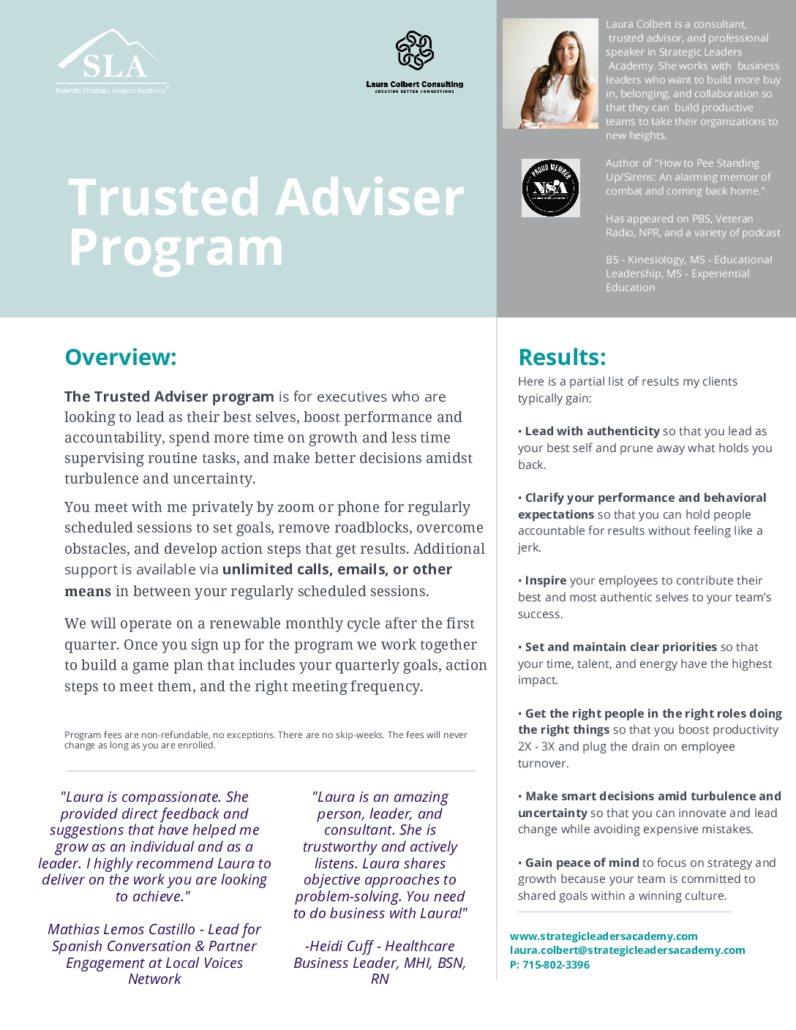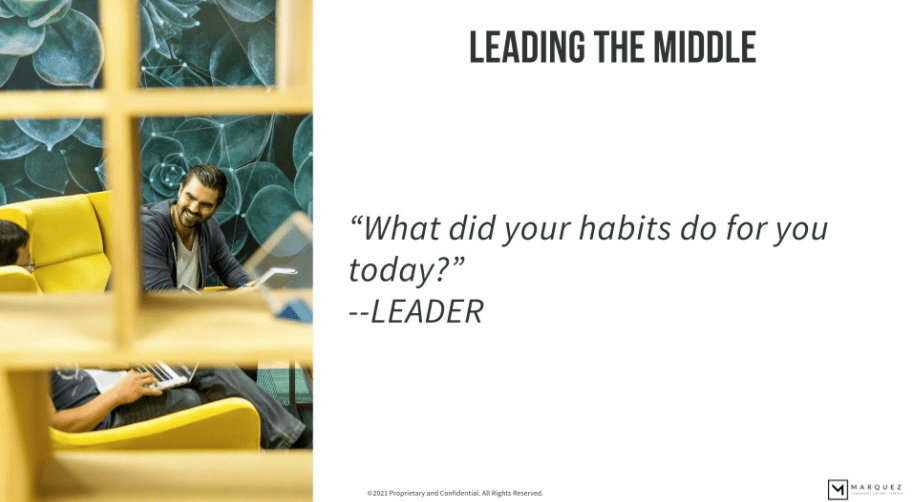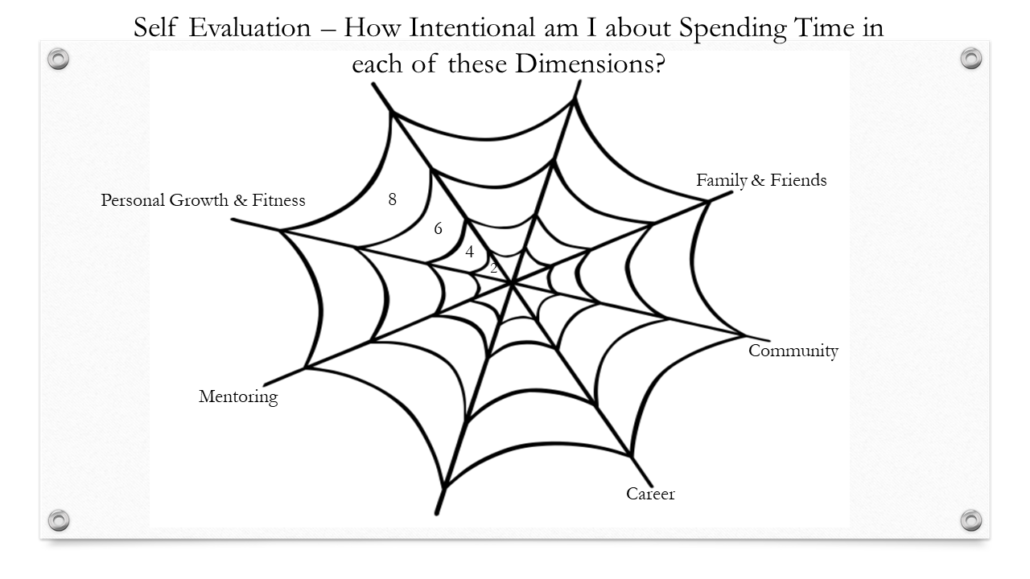Laura Colbert – Trusted Advisor Program
New Trusted Advisor Program


In August, over 4 million Americans quit their jobs — the so-called Great Resignation — despite COVID unemployment supplements expiring. Last Tuesday’s election delivered shockers such as a Republican winning Virginia’s gubernatorial election and Minneapolis, Seattle, and other cities rejecting Defund the Police advocates.
Common to these seemingly disparate events are a backlash against the finger-wagging classes who tell people to shut up and do as their self-appointed betters tell them to do. People are challenging the mandate-centric approach to leading and governing.

People don’t leave their jobs; they leave their bosses. Seventy-five percent of those who quit their jobs did so to get away from their managers (Gallup, 2019). The 2021 numbers could be even higher.
COVID has lowered people’s tolerance for bad bosses and self-appointed betters. Leaders — public and private — should be exemplars, not overlords.
Persuasion gains buy-in, which motivates people to provide their discretionary effort. Coercion may gain compliance, but it also creates resistance. People vote with their feet.
There are times when mandates are necessary. When you establish a reputation for using persuasion to gain buy-in, you will get the benefit of the doubt when a crisis emerges.

You wake up, go through the morning routine, and off to work you go; habits abound. When do you exercise and focus on your health? Do you read in the morning? You arrive at the office, log on, get your coffee, and do you. In your first meeting or phone call, you repeat the familiar opening words. Same place, same people. Do you always run the meeting?
Do you engage others, say good morning or hello? Is your door open or closed? Are your curtains open? Is your camera on? Can others see you, and is that what you prefer? Habits.
Are you happy with the Team’s productivity, or could it use a boost? Are your habits improving productivity, or could they use a boost?
Some habits help us. Other habits may be dragging us down, restricting our motivation, thinking, leading, and fun. Here is a word reminder to help you check on your habits:
𝗟isten, learn, laugh every day; listen to understand first, learn something new about yourself or your Team, and have some fun, laugh
𝗘xperience something new and help your Team do the same
𝗔ccountability of yourself and others, acknowledge others for their efforts
𝗗evelop or help someone every day; it may very well be the most important and satisfying thing you do
𝗘mpathize to broaden your understanding of other perspectives
𝗥ead every day; whether it is a book, devotional, or Stoic, to help you grow
Take five minutes and jot down your LEADER habits for the day and reflect on your growth. The experts say it takes anywhere from 21-60 days to form a new habit. You should see a boost in productivity in about that same time. That is the power of habits.

As the “Facebook Papers” continue to unfold showing us the fundamental gaps in Facebook’s values one can wonder if they uphold their values or, rather, if their values revolve around making more money and connections regardless of political turmoil or damage to the users. Are the teams functioning at top capacity with the whistleblowing? Is the company reassessing what they stand for?
When leading teams, empathy, integrity, and trust are vital. A shared set of values will create a strong and productive team. When someone compromises the values, the team struggles to trust and produce ethical results.
One of the leadership teams that I belonged to as a junior leader had two senior leaders with large personalities who leaned toward the negative side. I dubbed the meetings the “Tammy and Tim Show” because the meetings were no longer about the agenda, about the organization’s vision or mission, or even about developing solutions to the problems. We wasted hours throughout the years listening to Tammy and Tim grieve about their problems. Do you have a Tammy and/or Tim? Do you struggle to get the meetings back on track? If we had upheld our team’s core values and meeting norms of “start on time/end on time, collaboration, and sticking to the agenda” this wouldn’t have happened and the meetings would have been more productive and less dysfunctional.
Action steps to getting to the core of your values:
Stick to your values. The people in your life will have a better understanding of who you are, what you stand for, and why you do the things you do.
“Our values should be so crystallized in our minds, so infallible, so precious and clear and unassailable, that they don’t feel like a choice—they are simply a definition of who we are in our lives.” ~ Brene Brown.
“Daring leaders who live into their values are never silent about hard things.” ~ Brene Brown.
Are you looking for a Keynote Speaker at your next event? I use my past experiences and knowledge to show you how to be the best version of yourself, surround yourself with the right people, and build highly productive teams.
Book:
Sirens: How to Pee Standing Up – An alarming memoir of combat and coming back him. This book depicts the time of war and its aftermath. It seamlessly bridges the civilian and military divide and offers clarity to moral injury and post-traumatic stress.
Are you asking yourself, “How do I do this?” I can help!
laura.colbert@strategicleadersacademy.com
Get this newsletter delivered to your inbox. Click Here
Leading a balanced life is not a matter of dividing time. It’s being clear on your priorities and ensuring that you meet commitments in the important aspects of your life.
It’s easy to drift. You let your email inbox become your daily to-do list and get sucked into the social media vortex. You meet everyone’s demands, but you feel like the most important aspects of your life are passing by. I’ve been there.
Here’s a way to take back your life.

1. Identify the four or five most important aspects of your life. Career, Family & Friends, Health & Fitness, Community, Faith, Mentoring, among others, are common ones.
2. Create a bullseye or spider web chart with a spoke for each aspect. Label the rings 2-4-6-8-10.
3. Assess how well you feel that you are meeting commitments on each one. 0-2 = very poorly; 8-10 = highly satisfied.
4. Connect the dots. How happy are you with the picture?
5. To boost your engagement in a particular area, put time on your calendar for it and do not compromise that commitment.
6. Each morning, write down three things you want to accomplish that day. At the end of the day, write down three things that you achieved.
7. Find a partner or trusted adviser who will help you stay on track and do the right things the right way. Accountability shortens your path to success.
“THE KEY IS NOT TO PRIORITIZE WHAT’S ON YOUR SCHEDULE, BUT TO SCHEDULE YOUR PRIORITIES.” – Stephen Covey,
 |
| When teachers believe they can positively influence student learning through their collective actions, the students succeed at a rate almost four times faster than an average school year. This shared belief is called Collective Teacher Efficacy (CTE). A renowned researcher, John Hattie, and his team conducted meta-analyses on millions of students across the globe. They quantitatively measure influences on student achievement. Collective Teacher Efficacy is one of the most effective influences on student achievement; more so than socioeconomic factors, study time, teacher feedback, and student’s prior knowledge, to name a few. According to Jenni Donoho, a leading expert, teachers with CTE show greater effort and persistence, willingness to try new teaching approaches, and attend more closely to struggling students’ needs. I heard a story about a student who was not doing well in school. He struggled to pass his classes and did not seem to have much of a future. When he got his SAT scores back, he received 1400, which was enough to be accepted into college regardless of his high school transcript. That student went to college and successfully completed his first year. Shortly thereafter, he found out that the SAT issued him the wrong score. His actual score was much lower and reflected that of his K-12 career. When asked how he succeeded his first year in college, he responded that he finally believed in himself and his ability to succeed—something he had never possessed before. This student’s story is a perfect example of self-efficacy, which is the belief in oneself to execute the desired outcome. Let’s take CTE and self-efficacy and coin the phrase “Collective Efficacy.” This phenomenon can be transposed into business leadership. Collective Efficacy is your ability to build a strong team, a supportive network, and the ability to push your organization to new heights. When you have cheerleaders and people who fully believe in your ability to achieve your dreams, you’re unstoppable. Take a look at the model below. The Success Mindset model includes capacity, confidence, action, and results. If the word “low” precedes the words on the cycle, one can expect poor results. Inversely, if the word “high” precedes the words on the cycle, you can expect big results. The key is helping people believe in themselves and have the confidence to take action. |
 |

Are you asking yourself, “How do I do this?” I can help! laura.colbert@strategicleadersacademy.com
Get this newsletter delivered to your inbox. Click Here.
 |
| According to the Merriam-Webster Dictionary, renovation means to restore to a former better state. As my husband and I finish up the large job of residing our house and replacing all the windows, I can’t help but think of the parallels between this job and that of leadership―where one should strive to become the best version of oneself and to build an organization that allows their employees to do the same―to reach their best “state.” With three young children, it’s hard for my husband and me to find time for ourselves. Renovating homes―this being our third―has become something we both love to do together. Just like any team, there are growing pains, communication breakdowns, and assumptions that can lead to frustration. Regardless, we are better together because of our shared interests. Here are a few things we’ve learned: There need to be compromises – It’s hard to admit when you’re wrong or when the other person knows more than you. The sooner you put your ego aside, open your heart and mind to others’ opinions, and understand that their ideas are valuable, the process becomes more freeing and collaborative. Remember, empathy and vulnerability lead to stronger leadership.Communication, communication, communication – When my husband and I were moving the box that held our garage door, he tilted his head in a diagonal direction and said, “Lay it this way.” I started laughing and said, “Honey, I have no idea which direction your head is implying.” The more that we communicate, the better the outcome, and the quicker the results. Are you making assumptions or jumping to conclusions? Are your employees? Think about how you can create more clarity through communication. There are hidden obstacles around every bend. As leaders, we constantly need to innovate and adapt. Removing the 50-year-old siding has left my husband and me scratching our heads at the randomness left underneath. The rotted holes needed to be fortified, the missing insulation had to be filled, and the hodgepodge siding needed to be streamlined. Similarly, in business, leadership is about building your employees up, streamlining processes, and creating a clear picture of where your organization is headed. Working interdependently leads to better results. When my husband called me out of the office to lift the 300 pound 10×5 foot window into its home, I almost laughed at the absurdity. There was no easy way to lift this window with its straight lines and minimum edges for grip. Through our collaborative problem-solving, we figured out how to maneuver the window up and onto chairs and then over into its final resting place. Without our collective brainpower, we almost gave up. As an organization, know that you are better when you work as a whole instead of in silos. The end result is beautiful when executed patiently and to the best of your ability. Things are not built overnight. Life’s nuances, hiccups, and demands are never-ending. Be patient and always do your best. If it is your best, then you should be proud. Perfection is a fallacy. |
Are you asking yourself, “How do I do this?” I can help!
laura.colbert@strategicleadersacademy.com
Get this newsletter delivered to your inbox. Click Here.
Iran is building drones that fire ship-killing missiles while nerds with laptops launch business-crippling cyberattacks. The English longbow defeated the heavily armored French knight. “Two thousand pounds of education,” Kipling lamented of British officers shot down by rifle-wielding Pashtun fighters, “Drops to a ten-rupee jezail.”

Problem-solving restores performance to a set standard. Leaders who fixate on it do not move their organizations forward — they create yo-yos.

Innovation, on the other hand, takes you to new heights. The medieval English had a significant disadvantage: the French knights could outspend them on armor and thus win battles. Instead of investing in better armor, the English invested in the longbow and archers and invented tactics to enhance their effect. The Battle of Agincourt showed the innovation’s devastating effects.
Who’s helping you innovate so that your people, processes, and products give you a competitive advantage or make you distinct in the field?
Small businesses win when they think like David, not like Goliath.
 I’m delighted to offer you the opportunity to join me and six other leaders at my Antietam & Gettysburg exclusive event, December 7-10. The battlefields will build your imagination for the action steps to make 2022 your best year ever. Among the topics we typically discuss: *Action steps to put the right leaders on the scene and empower them to make decisions. *How to help your subordinates achieve “leader-on-horseback” inspiration so that people have clear examples to follow. *How to create innovation and gain a competitive advantage. Ways to set up your new subordinates for success and keep them winning. *Action steps that create clarity, buy-in, and accountability. Ways to let in fresh ideas and avoid smelling your own gunpowder. You’ll come away from the event with action steps that will power your success in 2022 and lifelong relationships with other great leaders that will boost the quality of your life. Find out more about the exclusive event here or paste this link into your browser: https://drive.google.com/file/d/1iNdcCraLLzL1ioHT7hZAS4XvnTpcDJ8j/view?usp=sharing Here’s what participants say about the event: Gain buy-in like Chamberlain; encourage people to take the initiative like Buford. This inspiring and interesting experience is giving me new tools and stories to develop leaders. Dick Gephardt, former Majority Leader, U.S. House of Representatives; CEO, Gephardt Group |

Matrixed organizations don’t work. They suffer a disorder similar to siloed ones: poor accountability. The Afghanistan failure is exhibit A; it’s the same principle in business.
Members of Congress and America’s punditry recently awoke to the calamity in Afghanistan. The war ranks at the top of the biggest foreign policy disasters in U.S. history. In his Senate testimony on September 28th, Joint Chiefs Chairman General Mark Milley admitted that we lost to a rag-tag militant group known as the Taliban. Cue the hue-and-cry. And yet, no one has been held accountable for the fiasco.
The reason is simple: there’s been no one on the ground in charge of the war.

Wait. What?
That’s right. There’s no one in charge on the ground, so there’s no one to hold accountable for success or failure. There’s no single American the President can look to and say, “you are responsible for achieving success in Afghanistan.”
The military has a portion of the responsibility: fighting the enemy and training the (defunct) Afghan Army. The diplomats are in charge of building the (defunct) Afghan government capacity and coordinating with allies and neighboring countries. The U.S. Agency for International Aid and Development (USAID) is responsible for helping the (destroyed) Afghan economy and infrastructure. In intelligence agencies coordinate clandestine operations and provide intelligence assessments, while training the (dismantled) Afghan intelligence agency.
There’s no one below the President of the United States who has the authority and responsibility for making it all work together half a world away. Everyone else works comfortably in their silos.
While the generals, diplomats, aid workers, and spooks each talked about their progress, the situation kept deteriorating. The main causes for failure include the vast corruption within the Afghan government and military, and the Taliban sanctuaries in Pakistan. These problems occurred in the fault lines between the silos. Because no one was in charge of U.S. efforts on the ground, no one had the authority to address them or to tell the President that we needed a new strategy.
© 2024 Chris Kolenda

There's no limit to your growth. Do you want to be a leader who gets better every day?